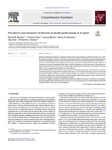Prevalence and correlates of burnout in health professionals in Ecuador

Use this link to cite
http://hdl.handle.net/2183/35352
Except where otherwise noted, this item's license is described as Atribución-NoComercial-SinDerivadas 3.0 España
Collections
- Investigación (FEDU) [938]
Metadata
Show full item recordTitle
Prevalence and correlates of burnout in health professionals in EcuadorAuthor(s)
Date
2018-04Citation
Ramírez, M. R., Otero, P., Blanco, V., Ontaneda, M. P., Díaz, O., & Vázquez, F. L. (2018). Prevalence and correlates of burnout in health professionals in Ecuador. Comprehensive psychiatry, 82, 73-83.
Abstract
[Abstract] Background: Although burnout is a widespread phenomenon among healthcare professionals, there are no studies about its prevalence in Ecuador. This study assesses the prevalence of burnout syndrome among Ecuadorian healthcare professionals and examine the relationship with their personal and organizational characteristics. Methods: A total of 2404 healthcare professionals (average age 40.0 years; 68.4%women) from the capitals of all 24 provinces in Ecuador participated in this study. Trained psychologists assessed the presence of burnout by applying theMaslach Burnout Inventory. Sociodemographic variables, emotional distress, social support and coping styles as well as organizational variables were also collected. Results: Of all healthcare professionals surveyed, 2.6% presented burnout syndrome. By dimensions, 17.2% of the participants presented a high level of emotional exhaustion, 13.5% of depersonalization, and 18.2% had reduced personal accomplishment. Being non-mestizo, being classified as a probable case of mental disorder and using more passive copingwere associatedwith a greater probability of presenting burnout; having N10 years of experience was associated with a lower probability of burnout.
Conclusions: A significant number of active health professionals suffer fromburnout. It is necessary to develop effective psychotherapeutic interventions for those who have the syndrome and to evaluate potential prevention strategies in those who have not yet developed it.
Keywords
Burnout syndrome
Health professional
Ecuador
Health professional
Ecuador
Editor version
Rights
Atribución-NoComercial-SinDerivadas 3.0 España Comprehensive Psychiatry is an open access, peer-reviewed journal that publishes on all aspects of psychiatry and mental health.
ISSN
0010-440X






